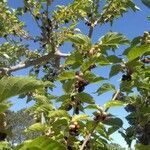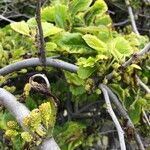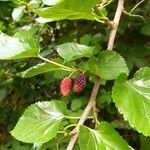A deciduous tree. It is a medium sized tree which grows 10-12 m high. The trunk is short and then branches widely. It has an extensive root system. The bark is dark brown. The young branches are hairy. The leaf stalk is 1.5-2.5 cm long. The leaf blade is oval and 6-12 cm long by 7-11 cm wide. The flowers are small and greenish. The fruit is blackish purple when mature. It is 2-2.5 cm long by 1.5-2.5 cm wide.











